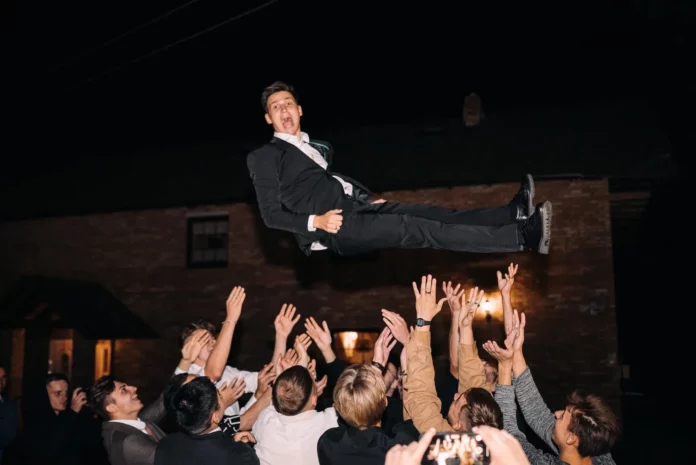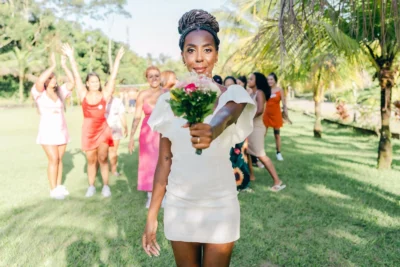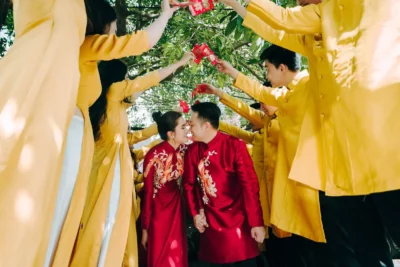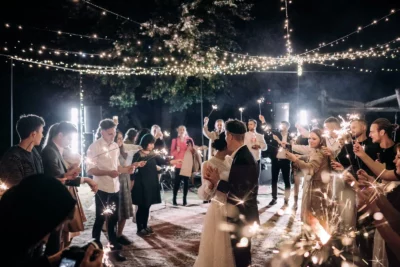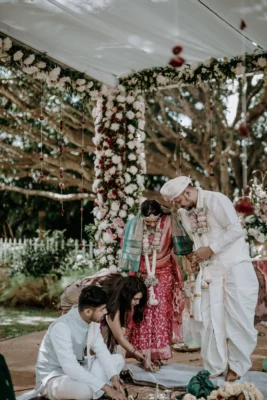When love blossoms and two hearts decide to entwine their destinies, a wedding becomes the beautiful union of souls. In India, weddings are not just ceremonies; they are grand spectacles of culture, tradition, and love. But they also come with a set of intricate wedding etiquettes that must be observed to ensure a harmonious celebration. Whether you’re the bride, groom, a member of the bridal party, or a guest, understanding and adhering to these customs can make the experience even more meaningful. So, let’s embark on a journey through the labyrinth of Indian wedding etiquettes and discover the secrets to navigating these elegant celebrations.
The Invitations: An Artful Prelude
Indian wedding invitations are a work of art. They are not just cards; they are a glimpse into the couple’s journey, their heritage, and their taste. These intricately designed invitations often arrive with a box of sweets or dry fruits. It’s customary to keep these boxes on display during the wedding as a sign of appreciation.
Tip: When you receive an Indian wedding invitation, respond promptly with your acceptance or regrets. This helps the hosts make necessary arrangements efficiently.
RSVP: Respect the Invitation
Responding to the invitation is not merely a formality; it’s a gesture of respect. It allows the hosts to plan the seating arrangements, catering, and other logistics. Ignoring or delaying your response can create unnecessary chaos.
Tip: If you’re unsure whether children are invited, check the invitation wording. If it mentions ‘and family,’ it typically includes children. Otherwise, assume it’s an adult-only affair.
Dress Code: The Elegance of Traditional Attire
Indian weddings are an opportunity to showcase your finest traditional attire. For men, this might be a beautifully embroidered sherwani or kurta-pajama, while women can dazzle in sarees, lehengas, or anarkalis. It’s a time to embrace vibrant colors, intricate embroidery, and timeless elegance.
Tip: Ensure your attire is culturally appropriate. Different regions in India have varying customs, so it’s wise to inquire about the specific dress code if you’re unsure.
Appropriate Colors and Styles
The choice of color is not arbitrary in Indian weddings. Red is considered auspicious, and it’s often the primary color for brides. However, guests should avoid wearing red, as it can be seen as an attempt to outshine the bride. Opt for vibrant yet complementary colors to celebrate the occasion without stealing the limelight.
Tip: When choosing your attire, remember that Indian weddings typically involve several events, each with its own dress code. Plan your wardrobe accordingly to avoid any last-minute stress.
Gifting: Thoughtful Gestures
Gifting is an integral part of Indian weddings. It’s a way to convey your blessings and good wishes for the couple’s new life together. Common wedding gifts include jewelry, home appliances, and cash. The amount of cash given can vary depending on your relationship with the couple and your financial capacity.
Tip: If you choose to give cash, consider presenting it in an envelope or a decorative gift box as a sign of respect.
Wedding Registry: A Modern Twist
Many Indian couples now create wedding registries to make it easier for guests to choose meaningful gifts. While traditional gifts are still appreciated, a registry can provide guidance and prevent duplication.
Tip: If you’re unsure about the couple’s preferences, consult their wedding registry or inquire with close family members for gift ideas.
The Ceremonies: Navigating the Rituals
Indian weddings are renowned for their intricate ceremonies, and each one has a specific significance. It’s crucial to arrive on time and participate respectfully. Being punctual demonstrates your commitment to sharing in the couple’s special day.
Tip: Familiarize yourself with the wedding schedule, so you’re aware of when each ceremony is set to begin. This will help you plan your arrival accordingly.
Rituals and Traditions: A Cultural Experience
Indian weddings are an immersive cultural experience, and understanding the significance of rituals adds depth to your participation. Whether it’s the exchange of garlands or the lighting of the sacred fire, each act has a profound meaning.
Tip: If you’re a non-Indian guest, don’t hesitate to ask questions about the ceremonies. Most hosts will appreciate your interest in their culture.
Dining Etiquettes: Savoring the Flavors of Celebration
Indian weddings often feature elaborate feasts with a wide variety of dishes. Depending on the scale of the wedding, you may encounter both buffet-style and seated service. In either case, wait for the elders or the bride and groom to start eating before you do.
Tip: Use your right hand to eat, as it’s considered more polite in Indian culture. Also, remember that many Indian dishes can be quite spicy, so be prepared for a burst of flavors.
Dietary Restrictions and Preferences
Indian cuisine is diverse, catering to various dietary preferences and restrictions. If you have dietary requirements, inform the hosts well in advance so they can accommodate your needs. However, be prepared to be flexible and try some traditional dishes; you might be pleasantly surprised.
Tip: Be polite when declining food you can’t eat due to dietary restrictions. A simple “No, thank you” suffices.
The Dance Floor: Groove with Grace
Indian weddings are known for their energetic dance performances. Even if you’re not a dancer, don’t hesitate to join the festivities. Your enthusiasm and presence on the dance floor will be appreciated.
Tip: If you’re unfamiliar with traditional dance moves, ask someone to teach you or simply follow along. Indian dance forms like Bollywood and Bhangra are relatively easy to pick up.
Respect Personal Space
While dancing is encouraged, remember to respect personal space. Avoid dancing too closely to someone without their consent, and be mindful of others on the dance floor. The aim is to have fun while maintaining decorum.
Tip: If you’re unsure about someone’s comfort level, it’s better to err on the side of caution and maintain a respectful distance.
The Parting Gesture: Expressing Gratitude
As the celebrations draw to a close, it’s essential to express your gratitude to the hosts for inviting you to share in their joy. A simple thank-you card or a heartfelt message can go a long way in showing your appreciation.
Tip: If you have any feedback or suggestions about the wedding, share them privately with the hosts rather than discussing them openly.
Sending Best Wishes
After the wedding, it’s customary to send the couple a congratulatory message or card. This is a thoughtful way to convey your best wishes for their future together and to let them know you’re still thinking of them.
Tip: If you’re close to the couple, consider a personalized gift as a post-wedding surprise to continue the celebrations.
In Conclusion
Indian weddings are a magnificent tapestry of tradition, culture, and love. By understanding and respecting the intricate wedding etiquettes associated with these celebrations, you can contribute to the harmony and beauty of the occasion. Whether you’re a key participant or a guest, your role in preserving these customs adds to the rich tapestry of Indian weddings.
So, the next time you receive an invitation to an Indian wedding, remember this comprehensive guide of wedding etiquettes, and embrace the elegance and grace that come with being part of this magical journey of love and tradition. Celebrate with warmth, dance with joy, and most importantly, share your blessings generously, for Indian weddings are not just ceremonies; they are celebrations of life and love.





